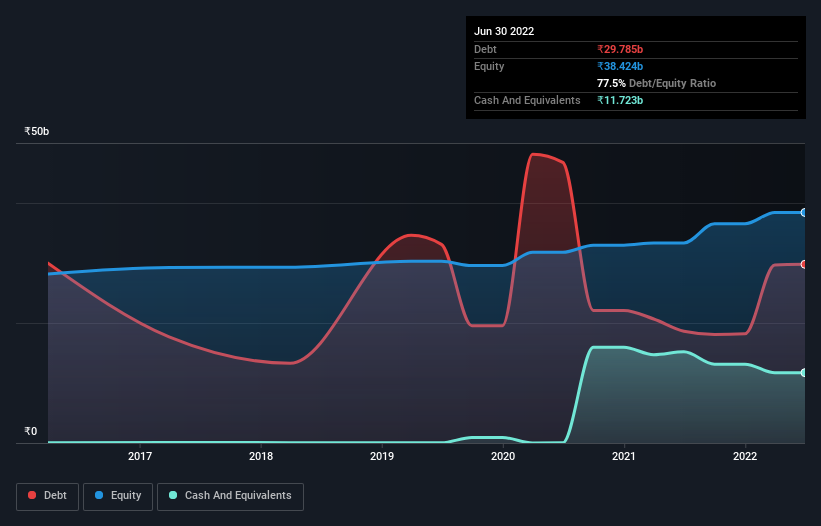Rashtriya Chemicals and Fertilizers (NSE:RCF) Seems To Use Debt Quite Sensibly
David Iben put it well when he said, 'Volatility is not a risk we care about. What we care about is avoiding the permanent loss of capital.' When we think about how risky a company is, we always like to look at its use of debt, since debt overload can lead to ruin. We can see that Rashtriya Chemicals and Fertilizers Limited (NSE:RCF) does use debt in its business. But the more important question is: how much risk is that debt creating?
When Is Debt Dangerous?
Generally speaking, debt only becomes a real problem when a company can't easily pay it off, either by raising capital or with its own cash flow. In the worst case scenario, a company can go bankrupt if it cannot pay its creditors. However, a more frequent (but still costly) occurrence is where a company must issue shares at bargain-basement prices, permanently diluting shareholders, just to shore up its balance sheet. Of course, plenty of companies use debt to fund growth, without any negative consequences. The first step when considering a company's debt levels is to consider its cash and debt together.
See our latest analysis for Rashtriya Chemicals and Fertilizers
What Is Rashtriya Chemicals and Fertilizers's Debt?
You can click the graphic below for the historical numbers, but it shows that as of March 2022 Rashtriya Chemicals and Fertilizers had ₹29.8b of debt, an increase on ₹18.6b, over one year. However, because it has a cash reserve of ₹11.7b, its net debt is less, at about ₹18.1b.

How Strong Is Rashtriya Chemicals and Fertilizers' Balance Sheet?
According to the last reported balance sheet, Rashtriya Chemicals and Fertilizers had liabilities of ₹50.3b due within 12 months, and liabilities of ₹16.0b due beyond 12 months. On the other hand, it had cash of ₹11.7b and ₹30.3b worth of receivables due within a year. So it has liabilities totalling ₹24.2b more than its cash and near-term receivables, combined.
Rashtriya Chemicals and Fertilizers has a market capitalization of ₹51.7b, so it could very likely raise cash to ameliorate its balance sheet, if the need arose. But we definitely want to keep our eyes open to indications that its debt is bringing too much risk.
We measure a company's debt load relative to its earnings power by looking at its net debt divided by its earnings before interest, tax, depreciation, and amortization (EBITDA) and by calculating how easily its earnings before interest and tax (EBIT) cover its interest expense (interest cover). Thus we consider debt relative to earnings both with and without depreciation and amortization expenses.
Rashtriya Chemicals and Fertilizers has net debt of just 1.3 times EBITDA, indicating that it is certainly not a reckless borrower. And this view is supported by the solid interest coverage, with EBIT coming in at 8.1 times the interest expense over the last year. On top of that, Rashtriya Chemicals and Fertilizers grew its EBIT by 47% over the last twelve months, and that growth will make it easier to handle its debt. When analysing debt levels, the balance sheet is the obvious place to start. But it is Rashtriya Chemicals and Fertilizers's earnings that will influence how the balance sheet holds up in the future. So if you're keen to discover more about its earnings, it might be worth checking out this graph of its long term earnings trend.
Finally, a company can only pay off debt with cold hard cash, not accounting profits. So it's worth checking how much of that EBIT is backed by free cash flow. Over the last three years, Rashtriya Chemicals and Fertilizers actually produced more free cash flow than EBIT. That sort of strong cash generation warms our hearts like a puppy in a bumblebee suit.
Our View
The good news is that Rashtriya Chemicals and Fertilizers's demonstrated ability to convert EBIT to free cash flow delights us like a fluffy puppy does a toddler. But truth be told we feel its level of total liabilities does undermine this impression a bit. Looking at the bigger picture, we think Rashtriya Chemicals and Fertilizers's use of debt seems quite reasonable and we're not concerned about it. While debt does bring risk, when used wisely it can also bring a higher return on equity. There's no doubt that we learn most about debt from the balance sheet. However, not all investment risk resides within the balance sheet - far from it. For instance, we've identified 2 warning signs for Rashtriya Chemicals and Fertilizers (1 doesn't sit too well with us) you should be aware of.
If, after all that, you're more interested in a fast growing company with a rock-solid balance sheet, then check out our list of net cash growth stocks without delay.
New: AI Stock Screener & Alerts
Our new AI Stock Screener scans the market every day to uncover opportunities.
• Dividend Powerhouses (3%+ Yield)
• Undervalued Small Caps with Insider Buying
• High growth Tech and AI Companies
Or build your own from over 50 metrics.
Have feedback on this article? Concerned about the content? Get in touch with us directly. Alternatively, email editorial-team (at) simplywallst.com.
This article by Simply Wall St is general in nature. We provide commentary based on historical data and analyst forecasts only using an unbiased methodology and our articles are not intended to be financial advice. It does not constitute a recommendation to buy or sell any stock, and does not take account of your objectives, or your financial situation. We aim to bring you long-term focused analysis driven by fundamental data. Note that our analysis may not factor in the latest price-sensitive company announcements or qualitative material. Simply Wall St has no position in any stocks mentioned.
About NSEI:RCF
Rashtriya Chemicals and Fertilizers
Manufactures, markets, and sells fertilizers and industrial chemicals in India.
Excellent balance sheet with proven track record.
Market Insights
Community Narratives




